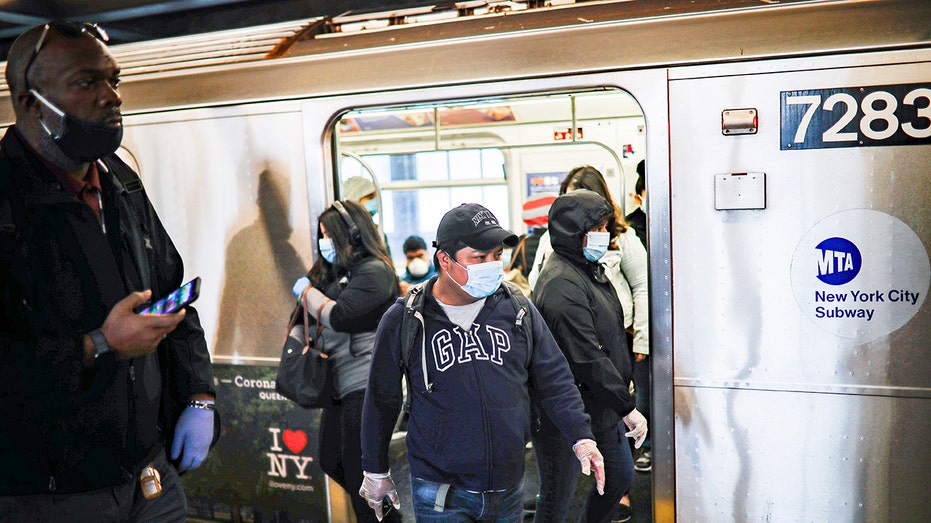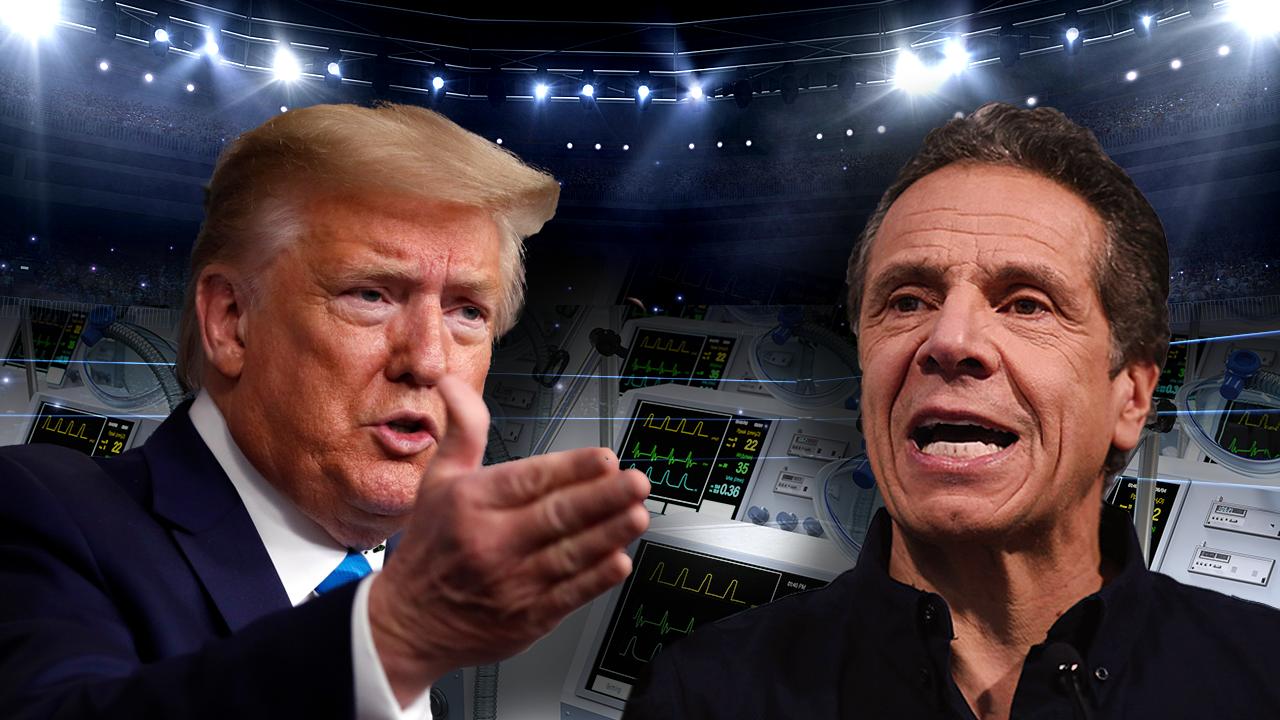Amid coronavirus pandemic, have sympathy for New York’s subway workers … but not for their bosses: David Asman
Working in or around a subway or a bus is now one of the most dangerous occupations in New York
Get all the latest news on coronavirus and more delivered daily to your inbox. Sign up here.
Health care workers are the obvious heroes of the coronavirus pandemic. But there are other essential workers who put themselves and their safety on the front line every day. The most unsung of these are public transit workers. They not only deserve our praise, they also deserve our sympathy.
In New York City, a dreadful new statistic is that 68 employees of the Mass Transit Authority (MTA) have died of coronavirus. Another 2,496 MTA employees (out of 71,000) have tested positive.
WHAT IS REMDESIVIR, GILEAD'S POSSIBLE CORONAVIRUS DRUG THAT'S IN TRIALS?
Think of that. Working in or around a subway or a bus is now one of the most dangerous occupations in New York.
We New Yorkers have a love-hate relationship with our mass transit system, the largest in North America. Everyone except the super-rich … and even some of them … depend on our busses and underground to get us quickly around and under New York’s snarled traffic.

Subway riders, wearing personal protective equipment due to COVID-19 concerns, step off a train, Tuesday, April 7, 2020, in New York. The new coronavirus causes mild or moderate symptoms for most people, but for some, especially older adults and peop
Still, there is a lot to complain about. At least once a week, we invariably complain loudly (is there any other way for a New Yorker to complain?) about a late or dirty subway car … or a nasty bus driver who closes the door in our face after we’ve sprinted half a block to catch up with him.
ABBOTT LABS TO SHIP 4M CORONAVIRUS ANTIBODY TESTS THIS MONTH
But complaints are now mute. Sixty-eight human beings who were part of our daily lives have suddenly died.
We need to know why.
Of course, maybe there’s no one to blame. Maybe it’s just the nature of the beast that the whole world is fighting right now. But maybe it’s at least in part an example of government inefficiency … in this case brutal inefficiency.
Government always operates less efficiently than the private sector. In fact, New York’s subway system got off to a great start because it was not a government operation.

A crowded subway train heading towards Queens, New York, during the coronavirus outbreak. (Photo by Braulio Jatar/SOPA Images/LightRocket via Getty Images)
It opened in 1904 as a private enterprise with competing subway lines. It worked so well that the city and state governments got greedy and began taking it over piece by piece.
By 1968, the state-controlled MTA had taken complete control. Not long after that, a state and city financial crisis hastened the deterioration of subways, buses and transit hubs, which became crime-ridden, graffiti-filled cesspools.
CENTRAL BANK CORONAVIRUS RESPONSE 'PUSHING ON A STRING': EL-ERIAN
During the Giuliani administration (1993-2002), there was a brief improvement, which continued for a few years after 9/11. But it wasn’t long before government and union inefficiencies crept back into the system, despite huge increases in fares and taxes … including an outrageous $3-$4 per ride “MTA Taxi Tax.”
We entered into another transit crisis in 2017, and that brought us right into the horror of the coronavirus.
Whether the government’s history of messing up mass transit in New York led directly or indirectly to the death of those 68 MTA workers is hard to say.
We do know that workers complain the MTA was slow in providing them with disinfecting kits, personal protective equipment and enforcement of social distancing.
We also know, according to the New York Times, that bureaucratic supervisors reprimanded workers who brought in their own disinfectant and tried to cordon off “safe spaces” among seats with their own duct tape. And new video of subway cars essentially turned into unsanitary homeless “shelters,” should give subway employees and riders alike serious concerns about the utter failure of MTA administrators to assure safe travel.
GET FOX BUSINESS ON THE GO BY CLICKING HERE
MTA Chairman Patrick Foye, who himself tested positive for the coronavirus, claims the bureaucracy “has taken aggressive action to protect the health and safety of our heroic workforce on the front lines of this crisis.” But words after death offer little consolation.
Workers in a transit system should not face odds in this pandemic worse than those faced by cops, firefighters and even health workers in ICUs.
So what to do? Instead of waiting for the same lame excuses and promises of better times to come, perhaps it’s time for something different. How about putting New York’s subways up for sale?
They began as a private venture and did damn well when they were private. It wasn’t until the city and state bureaucrats took over that things got inefficient, dirty, dangerous … and costly.
A 2017 New York Times report found that MTA construction costs were 5 times the international average.
A study by the Mises Institute found that despite having spent $100 billion since 1980 on infrastructure upgrades, New York subways still use a signal system from the 1930s!
Why? According to the Mises report: “perverse political incentives encourage spending on projects that produce short-term results over less glamorous, long-term alternatives like infrastructure repair.”
Keep in mind that these wasteful habits and outrageous expenditures took place when the subways had full ridership. After the coronavirus outbreak, it will be a while before commuters feel comfortable riding as before. Until then, the MTA will have virtually no source of income, other than subsidies from a state that is itself “broke,” as Gov. Cuomo recently admitted. New York may be forced to sell … but to whom?
WILL CORONAVIRUS CRISIS SPARK FRESH EXODUS FROM HIGH-TAX STATES?
There are only a few billionaires in the world who could step in and buy it. And why would they want to? The MTA loses about $6 billion dollars a year, and at some point soon, the system will need a major overhaul. A 2018 estimate to repair and refurbish the system came in at $37 billion!
Then there are personnel costs. Because of a politically powerful union, the average pay for an MTA employee is well over $80,000 a year. But the main reason that average is so high is because of an extremely top-heavy management.
More than one in four MTA employees make over $100,000 a year. There’s a burdensome mix of “agency heads,” “supervisors,” and “foremen” that would be unacceptable in any private organization. And it must be painfully pointed out, supervisors are supposed to look out for employees under their charge.
Clearly the deaths and infection of so many MTA workers proves these “managers” were not doing their job.
And for all the strikes against privatization, there are some examples around the world of where it worked … at least partially. Economic writer Scott Beyer wrote a piece in “Catalyst” on privatizing New York’s subways just this past November. He notes that in the UK, the government keeps control of the tracks, but many train operations are farmed out.
Hong Kong’s mass transit system sold 25% of its stock to private investors, which incentivized profitable expansions. And Tokyo’s largely private metro stays profitable, even though it must deal with government price controls. Beyer notes “there’s no reason New York City can’t implement one of these models—it has the density and demand to support profitable rail transit.”
Of course, Beyer’s words were written before the virus outbreak. Some would say that would make privatization more difficult to implement.
Others would say that after the death of 68 MTA workers, the implementation of something radical like privatization is more imperative now than ever.
David Asman joined FOX News Channel in 1997 and helped launch FOX Business Network (FBN) in 2007. He is the host of FBN’s post-market program "Bulls & Bears" (weekdays 5-6PM/ET). Read more.
CLICK HERE TO READ MORE ON FOX BUSINESS




















